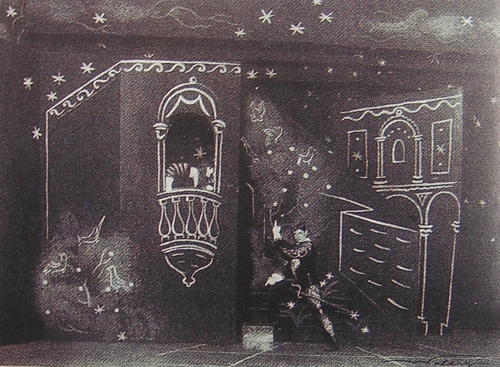Janet Griffin, director of public programs and artistic producer of Folger Theatre, selected this wonderful example of surrealist theatre, Jean Cocteau's Romeo et Juliette, for its daring design. This frontispiece and title page, published in 1926, can be found in the "Shakespeare's the Thing" exhibition, through June 15, 2014.
Jean Cocteau was a multi-talented French artist (1889 - 1963), whose circle of friends was also awe-inspiring and multi-talented: from Pablo Picasso and Erik Satie, to Edith Piaf and Coco Chanel, to Yul Brynner and Marlene Dietrich.
 |
|
|
Gifted painter and member of the 1920s French Surrealist movement, Jean Hugo is widely recognized for his contributions to graphics and stage design and his unique style of painting. He was the great grandson of Victor Hugo and “like his famous ancestor, he, for his generation, was one of the avant-garde. Jean Hugo was a part of the revolution in theater, poetry, music and dance after World War I” (John Andrew Frey). In 1921 he designed masks and costumes for Rolf de Maré’s Swedish ballet production of Jean Cocteau’s Les Mariés de la Tour Eiffel. Cocteau’s artistic influence, together with Diaghilev’s radical and provocative choreography, helped to revitalize ballet in France and laid the framework for modern interpretive dance. Cocteau’s Roméo et Juliette, however, while it depended largely upon the choreographic movement of characters on the stage, is not strictly a ballet, but rather what Cocteau called “an excuse for a stage production.” It was the first of his “textes-prétextes,” a form of play that he hoped would “save the French theater at whatever cost” (Crosland, 79). “Hugo designed a set whose hangings and floor would be of black cloth with colored linear decorations, and for the actors black tights and black velvet dresses, doublets and short hose, painted with ‘embroidery’ that would be picked out by lighting… ‘Red lights framing the stage,’ [Cocteau recalled], ‘kept the audience from seeing anything else” (Steegmuller, 328).
Reference:
SPLENDID FOLIO VOLUME OF HUGO’S DESIGNS FOR COCTEAU’S ROMÉO ET JULIETTE.
My guess is that the superb sets and lavish costumes overpowered the text, but that altogether the Cocteau production was a stunning one for the ages. As is my aspiration for Dr. Ron Art, he clearly brought together the genius of many artists, which, at the end of it all, was more than an excuse for theater.
A simple search on YouTube brought me this video. The following is a Google translation of the French text in its description box:
Incidental music based on English folk tunes arranged and instrumented by Roger Désormière, written in the spring of 1924 for Shakespeare's Romeo and Juliet adapted by Jean Cocteau, sets and costumes by Jean Hugo, for Evenings Paris Count Etienne de Beaumont at La Cigale in Paris.
It was Georges Auric who should be responsible for this partition, but he had to write the Annoying (given in January) for Diaghilev's Ballets Russes and vetoed his participation (as well as that of Poulenc for Beau Danube, Ballet Massine on Strauss waltzes).
So, Désormière, which was just directing the operation, had [the] charge to compose these partitions. In Romeo and Juliet, he used his knowledge of ancient music and saw the result, it includes a great future waiting in film music and also the Society of Music from the past, and his whole life to the service early music. In 1924, it is also right in the so-called Neo-classicism is recognized ... to 18 minutes Auld Lang Syne, known Francophone Scottish song under the name This is not a goodbye , which will also experience a huge cinematic vogue, started the following year with the Gold Rush Chaplin. For representation at 1:30 (against nearly 3 hours to the original work), there are 23 minutes 30 music, including drums pounding for the death of the lovers.
Jean Cocteau revived "his" work in March 1935 at the Colonial Radio, then in 1937, 5 March first Relais Paris PTT, Rennes, and Sunday, November 28, 1937, at 20:30, the "May 36" group on Paris PTT ; the same Thursday, April 20, 1939, 8:30 p.m. ET with a new production of Radio-Paris Tuesday, June 6, 1939.
After the war, it continues. Romeo and Juliet National Programme, Tuesday, May 21, 1946, 21h, music and conducting Roger Désormière. A new version in 1949: National Chain, 1st November, a new playout with Jean Marais and Josette Day ... We can say that this is either a musical document recovery 46 is a record of 49.
And will continue with a new cast Wednesday, January 10, 1954, avect a new record music under the direction of Pierre-Michel Le Conte. Rediffusion August 7, 1960 (National Channel, 1:35 p.m.).
Google translation, flawed algorithms and all, at least gives us more background on the Cocteau production. Even though the invention of TV stretched back to the late 1880s, it only became commercially available in the late 1920s and another handful of decades before it was to become a household mainstay. So, besides the stage, Cocteau had recourse only to vinyl records and radio broadcasts of his production. But apparently he got good mileage of it, staging it until his dying days.





No comments:
Post a Comment